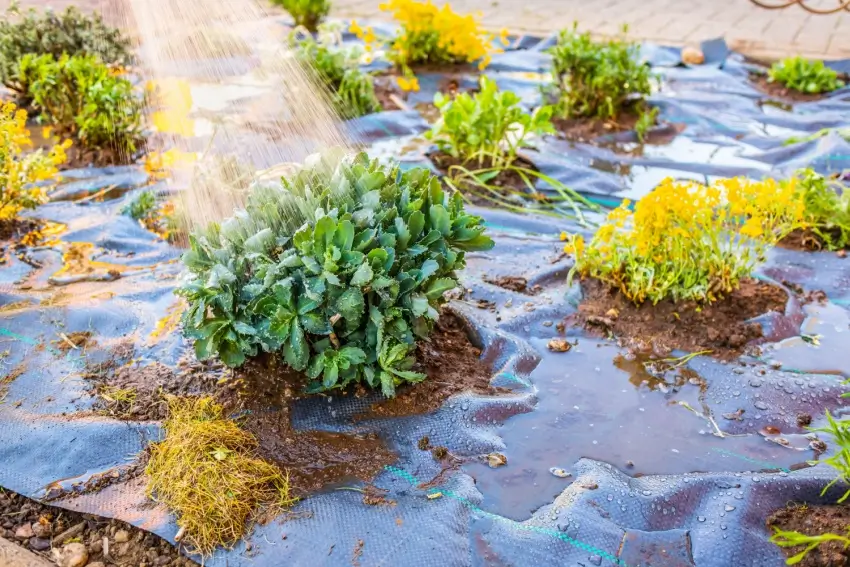Landscaping Fabric Pros and Cons

Are you tired of battling weeds in your garden or landscape projects? You may have heard that landscape fabric could solve your weedy woes. Also known as “weed barrier” or “geotextile,” landscape fabric is a permeable material you put over your soil to literally cover weeds and prevent them from growing. But is landscape fabric really your best choice to fight weeds?
Ask a hundred different landscapers, and you’ll get a hundred different opinions about landscape fabric. Ultimately, you’ll need to make your own decision after learning about the pros and cons of landscape fabric.
Table of Contents:
What Is Landscape Fabric Made Of?
If you’ve wandered the aisles of your local gardening store, you probably noticed huge rolls of black fabric on the shelves. This is a weed barrier. Typically, it’s made from synthetic materials like polypropylene or polyester, which are strong and resistant to tear and decomposition.
The main job of landscape fabric is to suppress weeds by preventing them from germinating and growing through the material. Many homeowners and property managers then place gravel or mulch over the landscape fabric to cover it.
If you plan to put down landscape fabric in your garden or other areas with ornamental plants, you’ll need to cut holes in the fabric to allow your plants to grow through. Some landscape fabric has cutouts already in place to make this process easier. (Learn more about how to use landscape fabric.)
The Pros and Cons of Landscape Fabric
Some gardeners love the convenience and effectiveness of landscape fabric, while others never touch the stuff. For you to decide, you need to understand all the main landscaping fabric pros and cons.
Benefits of Landscape Fabric

Landscape fabric generally works at its intended purpose, which can significantly reduce the time, effort, and frustration of weeding. Additionally, weed barriers also offer a few other useful advantages:
- Helps soil retain moisture by reducing evaporation, which can lower watering needs
- Stabilizes the soil to resist erosion (especially when used beneath gravel and mulch)
- Some fabrics enhance soil drainage, preventing water from pooling
Drawbacks of Landscape Fabric
With so many valuable benefits of landscape fabric, why would anyone not start rolling sheets of it over their garden beds immediately? The main reason is that landscape fabric can hinder the natural process of organic matter breaking down and enriching the soil. Soil needs direct contact with air, sun, and rain in order to thrive. A weed barrier literally gets in the way of that connection, which can hurt the overall health of your soil.
You’ll also have to contend with a few other important cons of landscape fabric:
- Leads to compacted soil and nutrient deficiency
- Eventually breaks down over time and needs to be replaced
- Burden to remove if you decide to change your landscape design
- Kills off helpful organisms in the soil, such as earthworms
- Weeds may still find a way to grow, especially if they root on top of the fabric
How Long Does Weed Barrier Last?
Unfortunately, landscape fabric won’t last forever. Over time, you’ll need to replace it. High-quality landscape fabric can last anywhere from five to 15 years, while lower-quality materials will degrade faster.
Several factors can affect the longevity of your landscape fabric:
- UV resistance
- Soil conditions
- Climate
- Installation
- Mulch or topping
After a few years, it’s a good idea to inspect your landscape fabric regularly and address any holes, damage, or other wear.
Alternatives to Landscape Fabric
.webp)
Many property owners would prefer not to use synthetic materials on their land. The good news is that you don’t have to. If, after reviewing the pros and cons of landscape fabric, you’d like a more natural option for keeping weeds at bay, you’ve got options.
- Organic mulch: Applying a thick layer of organic mulch can suppress weed growth, retain moisture, and gradually enrich the soil as it decomposes. Mulch options include wood chips, bark, or shredded leaves.
- Cardboard: Laying down cardboard creates a biodegradable weed barrier that will eventually break down and improve your soil’s structure. Another option is to lay down newspaper, which will break down faster than cardboard.
- Ground covers: Dense, low-growing ground covers like creeping thyme, sedum, or moss can help outcompete weeds and reduce the need for mulching.
- Inorganic mulch: Materials like gravel, pebbles, rubber, or crushed stone can help suppress weeds. They work well in drought-tolerant landscapes and rock gardens.
Using Landscape Fabric: Making the Best Choice for Your Garden
Now that you know the pros and cons of a weed barrier, you’ll need to decide if you want to add it to your next gardening or landscaping project. There is no right or wrong answer. Every gardener has different tools they prefer to use. What matters is that you take action to create the landscape you envision.
If you’re having trouble getting your next landscaping project off the ground, we’re here to help. The Grounds Guys® has local teams across North America ready to take on residential and commercial landscaping services. We can help you plan and put in a garden, create unique hardscapes, or simply keep your lawn looking great on an ongoing basis. Find your local The Grounds Guys.
Whatever you need, we’re the landscaping experts. Request a free estimate today.
This article is intended for general guidance only and may not be applicable to every situation. You are responsible for determining the proper course of action for your property and your situation. The Grounds Guys is not responsible for any damages that occur as a result of any advice or guidance derived from blog content. For the most accurate guidance, contact an independently owned and operated Grounds Guys for more information and a professional on-site assessment.
 Click to call
Click to call


